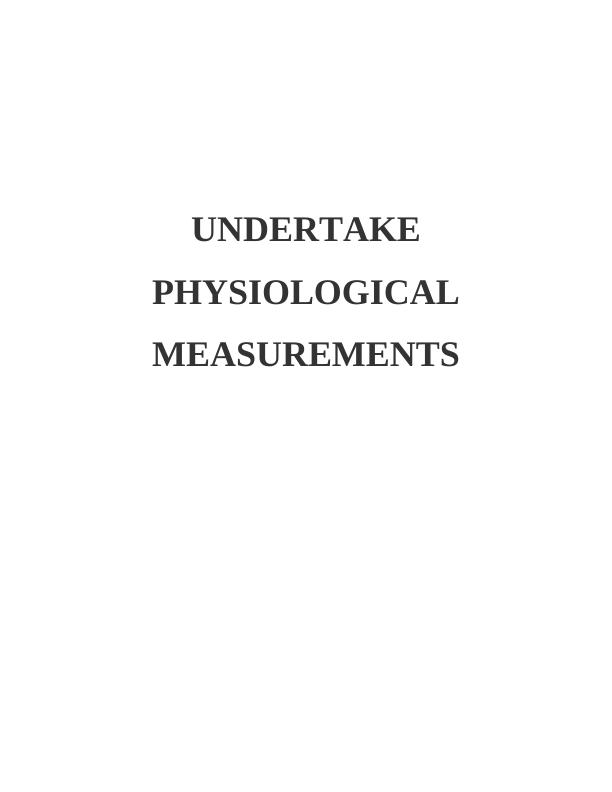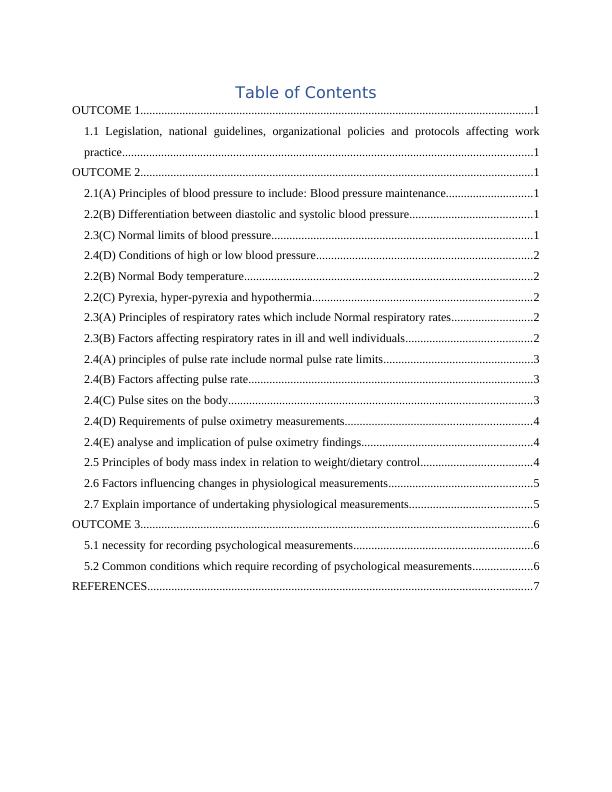Undertaking Physiological Measurements
11 Pages3208 Words246 Views
Added on 2020-10-22
Undertaking Physiological Measurements
Added on 2020-10-22
ShareRelated Documents
UNDERTAKEPHYSIOLOGICALMEASUREMENTS

Table of ContentsOUTCOME 1...................................................................................................................................11.1 Legislation, national guidelines, organizational policies and protocols affecting workpractice.........................................................................................................................................1OUTCOME 2...................................................................................................................................12.1(A) Principles of blood pressure to include: Blood pressure maintenance.............................12.2(B) Differentiation between diastolic and systolic blood pressure.........................................12.3(C) Normal limits of blood pressure.......................................................................................12.4(D) Conditions of high or low blood pressure........................................................................22.2(B) Normal Body temperature................................................................................................22.2(C) Pyrexia, hyper-pyrexia and hypothermia.........................................................................22.3(A) Principles of respiratory rates which include Normal respiratory rates...........................22.3(B) Factors affecting respiratory rates in ill and well individuals..........................................22.4(A) principles of pulse rate include normal pulse rate limits..................................................32.4(B) Factors affecting pulse rate...............................................................................................32.4(C) Pulse sites on the body.....................................................................................................32.4(D) Requirements of pulse oximetry measurements..............................................................42.4(E) analyse and implication of pulse oximetry findings.........................................................42.5 Principles of body mass index in relation to weight/dietary control.....................................42.6 Factors influencing changes in physiological measurements................................................52.7 Explain importance of undertaking physiological measurements.........................................5OUTCOME 3...................................................................................................................................65.1 necessity for recording psychological measurements............................................................65.2 Common conditions which require recording of psychological measurements....................6REFERENCES................................................................................................................................7

OUTCOME 11.1 Legislation, national guidelines, organizational policies and protocols affecting work practiceFor psychological measurements there are many standard precautions that are needed tobe taken into account. There are some legislations that should be followed for takingpsychological measurements like:Confidentiality- According to the law patients’ details should be kept confidential whiletaking their psychological measurements.Health and safety Act 1974- Knowledge about health and safety act at work should beknown be all the employees, as it shows employees their responsibilities like work itemsshould be used correctly etc. (Zingg and et.al., 2015)Consents- It is important for health care workers to have patient's consent beforepsychological measurements are taken, as patients have rights to withhold or grantconsent.Blood pressure can be defined as the measure of the force that heart uses to pump blood aroundthe body.OUTCOME 2 2.1(A) Principles of blood pressure to include: Blood pressure maintenanceNormal blood pressure can be maintained by losing excess weight. There is no doubt thatif extra weight pile on then blood pressure also increases.Regular exercising releases nitric acid which helps in reducing blood pressure.Eating healthy food also helps in reducing blood pressure.Too much salt intake should be avoided, as salt is one of the main reason BP increases.Smoking and drinking alcohol should also be avoided. These are the two bad habits thatcan help in reduction of BP.2.1(B) Differentiation between diastolic and systolic blood pressure Diastolic pressure can be defined as the minimum pressure of arteries that occurs at thestarting of cardiac cycle. Systolic pressure can be defined as the peak pressure of arteries thatoccurs at the end of cardiac cycle (Lonn and et.al., 2016). The difference between thesepressures is called pulse pressure.2.1(C) Normal limits of blood pressureNormal limits of diastolic pressure: (adults) 60 to 80 mmHg, (children) 65 mmHg1

Normal limits of systolic pressure: (adults) 90 to 120 mmHg, (children) 95 to 100 mmHg2.1(D) Conditions of high or low blood pressureThere are three conditions of blood pressure i.e. hypotension, pre-hypertension and hypertension:Hypotension: diastolic reading: less than 60 mmHg, systolic reading: less than 90 mmHgPre-hypertension: diastolic reading: 81 to 90 mmHg, systolic reading: 121 to 140 mmHgHypertension: diastolic reading: over 139 mmHg, systolic reading: over 89 mmHg2.2(B) Normal Body temperatureNormal body temperature varies for children and adults (Reshetnik and van der Giet,2018). Based on age normal body temperature is estimated as:Children: In babies of children it varies from 36.6°C to 37.2°CAdults: In adults it ranges from 36.1°C to 37.2°CAdults over age 65: in older adults it is lower than 36.2°C2.2(C) Pyrexia, hyper-pyrexia and hypothermiaPyrexia: It is also known as fever, when body is having temperature above normal rangeis called pyrexia. Normally it does not go higher than 41 or 42°CHyper-pyrexia: It is another term of very high fever. It is a medical emergency when bodytemperature is more than 41.5°CHypothermia: It is a medical emergency which occurs when body loses heat faster than itproduces heat due to which body temperature decreases dangerously low. It occurs whenbody temperature is lower than 35°C2.3(A) Principles of respiratory rates which include Normal respiratory ratesRespiratory rate is the rate at which breathing occurs (Marui and et.al., 2017). It isnormally measured in breaths per minutes and is set by respiratory rate.Babies less than 6 weeks: 30 to 40 breaths per minuteschildren less than 6 years: 20 to 30 breaths per minutesAdults: 12 to 18 breaths per minuteselders above 80 years: 10 to 30 breaths per minutes2.3(B) Factors affecting respiratory rates in ill and well individualsThere are various factors that affect the respiratory rates in an individual:Age: Younger children normally have high oxygen demand so they need to breath faster.2

End of preview
Want to access all the pages? Upload your documents or become a member.
Related Documents
Unit 314: Undertake Physiological Measurementslg...
|11
|4051
|5635
Lesson Plan Manual Blood Pressure Measurementlg...
|12
|2553
|306
Routine Measurements of Body Systemlg...
|1
|745
|70
Heart Failure in Elderly Patientslg...
|18
|6448
|37
Nursing Case Study Analysis | Reportlg...
|11
|2938
|32
Nursing Australia Case Study 2022lg...
|9
|2135
|36
